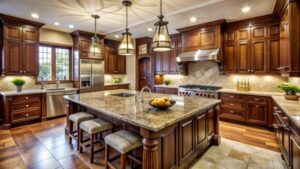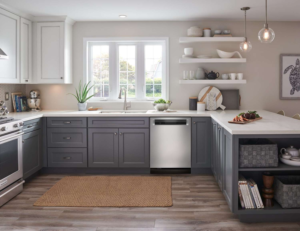Cabinet Refinishing Sacramento requires precision, and is not a DIY-friendly project. Professional installation ensures a precise fit and finish, maximizing durability.

Even the best paint jobs don’t last long in kitchen environments where cabinets are constantly exposed to moisture and grease. NHance’s meticulous surface prep and multiple coats of high-quality finish ensure durable results that look brand new.
Refinishing offers a cost-friendly alternative to replacing existing cabinets, and it can offer an updated aesthetic for your kitchen. It also provides increased durability, making it a smart option for homeowners who want to invest in a long-term kitchen upgrade. To ensure that your new finish lasts, it’s important to follow proper preparation techniques and use high-quality materials. Rushing or cutting corners can lead to unsatisfactory results, necessitating a project redo.
The first step in the cabinet refinishing process is to remove any hardware from the doors and sand down the cabinet surfaces. Start with coarse-grit sandpaper to strip away the old paint or stain, then switch to finer grits to smooth the surface. Be sure to wear a dust mask when working with sandpaper, and always work in a well-ventilated area to avoid breathing in any hazardous fumes. When sanding, it’s important to move with the grain for best results.
Next, inspect the cabinet surfaces for any imperfections such as dents or scratches. If necessary, fill these in using wood filler and a putty knife, then sand the surface again. Once the sanding is complete, apply a wood conditioner to prepare the surfaces for painting. This helps the new finish adhere to the surface, and it also prevents any warping or chipping over time.
Finally, wipe the cabinets down and clean up any areas where dust or debris may have accumulated. After allowing the cabinets to dry, reattach the hardware, making sure each piece goes back in its proper place. If you’ve labeled the cabinet door hardware as described above, it should be easy to find its proper home once everything is reassembled. Once the cabinet refinishing is complete, apply a clear coat to protect the cabinets and give them a glossy shine.
Sanding
In order to refinish cabinets, the original layer of paint or stain must be stripped and the surface smoothed. The sanding process usually begins with rough grit and gradually progresses to finer grits. This ensures that the new finish adheres properly and produces a smooth texture.
Before the final sanding, we typically apply a coat of wood filler. This is important to patch any holes or cracks. A high-quality wood filler can help restore cabinet surfaces to pristine condition and eliminate the appearance of holes, nicks, and scratches. After the patch is dry, it must be sanded again before applying the final two top coats of stain.
After the sanding and patching, the cabinet boxes are prepared for painting. This is the most time-consuming part of the entire refinishing process. We carefully label and remove each cabinet door and drawer front, and we take extra care to protect the kitchen interiors from dust and dirt. We also cover backsplashes and seal off appliances to keep them clean throughout the project.
When compared to refacing, refinishing is a more affordable option for those who want to update their kitchen’s look without breaking the bank. However, it is best suited for cabinets with only minor surface damage such as scratches or faded finishes. For a more dramatic change, consider cabinet refacing, which involves replacing the doors and drawer fronts entirely. This provides more flexibility in style, material, and color choice and allows homeowners to modify the size of their cabinet doors if necessary. You can learn more about this process by viewing a few examples of our cabinet refacing work here. Our team can help you determine which option is right for your home!
Primer
Choosing the right product is one of the most important parts of any refinishing project. The wrong choice can lead to a job that chips, peels, and cracks easily. Many products are available, from inexpensive and low-quality to high-end professional grade. The right choice will make your cabinets look new again, and last longer.
When painting porous surfaces, like wood or gypsum board, a primer is often used to improve adhesion. Primer also helps to smooth and prepare the surface for staining or paint. Many primers are formulated for specific surfaces or finishes, and should be used as directed to ensure the best results.
Before you can stain your cabinets, you should sand the surfaces to remove any scratches or blemishes. It is important to use a high-quality, cabinet-grade sandpaper to get the best results. It is also important to vacuum the sanded surface and wipe it down with a damp cloth to remove any remaining dust.
Once the surface is dry, you should apply a stain to the cabinets. Stains come in a variety of colors and shades, so you can find the perfect fit for your home. Staining the cabinets is an excellent way to make them look brand new, and it is much cheaper than replacing them or purchasing new ones.
After your refinishing is complete, it is important to seal the cabinets with a high-quality sealant. This will protect the finish from moisture and stains, prolonging its lifespan. Your refinisher should be able to recommend the proper product for your cabinets. Once the sealant is applied, it should be allowed to dry completely before using your kitchen again. This will usually take 24 hours or more, depending on the type of sealant and its application.
Paint
When the surfaces are clean, dry and ready for paint, you can apply a high-quality primer. For cabinets, consider using a stain-blocking primer to prevent old stains from bleeding through the new finish. The primer should be easy to apply and dry quickly, with low odor so you can remain at home during the process.
After applying the primer, lightly sand the cabinet doors and drawer fronts to smooth them out. Then vacuum or wipe down the surfaces again to remove any dust from sanding and prepare them for painting. You can use a foam sanding block to scuff the surface for better adhesion but don’t go any deeper than bare wood.
A tinted primer can also help eliminate the need for sanding between coats and ensure your topcoat adheres properly. Sherwin-Williams recommends their Extreme Bond Primer, which is specifically designed to adhere to painted or raw wood, laminate and melamine surfaces. If you want to be sure of quality adhesion, she suggests doing a spot test on an inconspicuous area with the primer to see how it holds up.
Then you can apply a coat of the protective topcoat on the cabinet frames with a brush and roller. Wait 3-4 hours for the topcoat to dry and then inspect and reapply where necessary. The protective topcoat takes 7 days to fully cure, so you should avoid using cleaning agents on the surface during that time. Once the topcoat is cured, you can replace the cabinet hardware for a complete finish. You could even repurpose the old knobs and handles to give your kitchen a completely new look. If you’re not able to get the exact style of hardware you’re looking for, spray paint can work wonders in some cases.
Assembly
If your cabinet doors are solid but aren’t quite what you want, add some flare to them with glass door inserts. This is a quick and cost-effective way to give your kitchen a stylish makeover without breaking the bank. There are a variety of options for glass inserts, including plain, etched, and fluted. Talk to your contractor about the best option for your home and budget.
When painting the cabinet frames, you’ll want to put down a good layer of primer first. This helps the paint adhere to the surface and prevents chipping or peeling down the road. Then, once the primer has a chance to dry completely, you can move on to the actual painting process. It’s important to use a quality brush or sprayer for the job, as the results will be much better than trying to do it by hand with a regular paintbrush.
It’s also a good idea to use a high-quality paint that you’re comfortable working with. There are many different finishes available for cabinets, so find one that matches your aesthetic and is easy to work with. If you’re having trouble deciding on a color, ask for samples from your local hardware store to help narrow it down.
After the paint dries, you can reassemble your kitchen cabinets. Be sure to follow the labeling system you created at the beginning so you can return everything back to its correct place. If you added knobs or pulls, be sure to install them properly before putting the doors back on. Once you’re done, your new cabinets will look as good as new!

